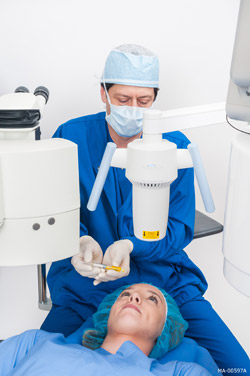Corneal Cross-Linking at the Refractive Surgery Center
A New Standard of Care for Progressive Keratoconus
 Keratoconus, often referred to as “KC”, is a non-inflammatory
eye condition in which the typically round dome-shaped cornea progressively
thins and weakens, causing the development of a cone-like bulge and optical
irregularity of the cornea.
Keratoconus, often referred to as “KC”, is a non-inflammatory
eye condition in which the typically round dome-shaped cornea progressively
thins and weakens, causing the development of a cone-like bulge and optical
irregularity of the cornea.
At the Refractive Surgery Center, we use a minimally invasive, FDA approved, outpatient procedure called Cross-Linking that combines the use of prescription eye drops, Photrexa Viscous, Photrexa, and ultra-violet A (UVA) light from the KXL system for the treatment of progressive keratoconus.
What can I expect during the procedure?
- After numbing drops are applied, the epithelium (the thin layer on the surface of the cornea) is gently removed.
- Photrexa Viscous eye drops will be applied to the cornea for at least 30 min;
- Depending on the thickness of your cornea, Photrexa drops may also be required.
- The cornea is then exposed to UV light for 30 minutes while additional Photrexa Viscous drops are applied.
What is ultra-violet A (UVA) light?
UVA is one of the three types of invisible light rays given off by the sun (together with ultra-violet B and ultra-violet C) and is the weakest of the three.
Does corneal cross-linking require removal of the epithelium?
Yes, your doctor will apply topical anesthesia to numb the eye prior to the removal of the eipthelium. This process helps to prepare your eye so that the drug can penetrate the tissue of the cornea to have an effective cross-linking procedure.
Am I awake during the procedure?
Yes, typically you will be awake during the treatment. You may be given a medication to help you relax, and numbing anesthetic drops.
How long does the treatment take?
The actual procedure takes about an hour, but you will be at the office for approximately two hours to allow sufficient time for preparation and recovery before you return to the comfort of your own home.
What can I expect after the procedure?
- You should not rub your eyes for the first five days after the procedure.
- You may notice a sensitivity to light and have a foreign body sensation. You may also experience discomfort in the treated eye and sunglasses may help with light sensitivity.
- If you experience severe pain in the eye or any sudden decrease in vision, you should contact your physician immediately.
- If your bandage contact lens from the day of treatment falls out or becomes dislodged, you should not replace it and contact your physician immediately.
Does insurance cover cross-linking?
Insurance coverage for FDA approved cross-linking is becoming more widely available as an increasing number of commercial insurance carriers are recognizing the medical necessity of the procedure.
For additional information on insurance coverage and financing options, call the Refractive Surgery Center at 973-322-7185.
Can anyone tell by my appearance that I have had cross-linking?
No. There is no change in the appearance of your eyes following cross-linking.
Is cross-linking right for me?
Patients who have been diagnosed with progressive keratoconus should ask their doctor whether they may be an appropriate candidate for corneal cross-linking.
Will I need to be out of my contact lenses for this process?
Yes. Typically, patients are asked by their doctor to stop wearing hard contact lenses prior to surgery for a period of several weeks. Once treated, patients will not be allowed back into contact lenses for one month.
For more information or to make an appointment, call the Refractive Surgery Center at 973-322-7185.
